Flood Modeling in a Composite System Consisting of River Channels, Flood Storage Areas, Floodplain Areas, Polder Areas, and Flood-Control-Protected Areas
Abstract
1. Introduction
2. Materials and Methods
2.1. Study Area
2.2. Framework for the Setup of the Flood Model
2.2.1. Model Generalization
2.2.2. Flood Routing Modeling in the River Channels
2.2.3. Floodwater Storage Modeling in the Polder Areas
2.2.4. Flood Inundation Modeling in the Areas Outside the Channels
2.2.5. Interaction Modeling between the River Channels and the Areas Outside the Channels
2.3. Model Inputs
2.3.1. Bathymetry
2.3.2. Measured Hydrographs Used for Model Parameter Calibration
2.3.3. Flood Control Structural Measure Conditions and Operation Rules
2.3.4. Design Flood Hydrographs
2.4. Scenario Settings
3. Results
3.1. Verification of the Rationality of the Flood Model
3.1.1. Flood Process Re-Inspection in River Channels
3.1.2. Calibration of the Bed Resistance in the 2D Model
3.2. Riverine Flooding in the Design Flood Event
3.3. Flood Storage Process in Flood Storage Areas
3.4. Flood Inundation in Flood-Control-Protected Areas and Polder Areas
3.5. Flooding in Floodplain Areas
4. Discussion
4.1. Effectiveness of the Flood Model for the Study Area
4.2. Flood Model Setup for the Composite System
4.3. Flood Control Structural Measures Used in the Exceeding Standard Flood
5. Conclusions
Author Contributions
Funding
Data Availability Statement
Acknowledgments
Conflicts of Interest
References
- Duan, W.; He, B.; Nover, D.; Fan, J.; Yang, G.; Chen, W.; Meng, H.; Liu, C. Floods and Associated Socioeconomic Damages in China over the Last Century. Nat. Hazards 2016, 82, 401–413. [Google Scholar] [CrossRef]
- Kundzewicz, Z.; Su, B.; Wang, Y.; Xia, J.; Huang, J.; Jiang, T. Flood Risk and Its Reduction in China. Adv. Water Resour. 2019, 130, 37–45. [Google Scholar] [CrossRef]
- Xia, J.; Chen, J. A New Era of Flood Control Strategies from the Perspective of Managing the 2020 Yangtze River Flood. Sci. China Earth Sci. 2021, 64, 1–9. [Google Scholar] [CrossRef]
- Kryžanowski, A.; Brilly, M.; Rusjan, S.; Schnabl, S. Review Article: Structural Flood-Protection Measures Referring to Several European Case Studies. Nat. Hazards Earth Syst. Sci. 2014, 14, 135–142. [Google Scholar] [CrossRef]
- Sun, T.; Cheng, W.-Q.; Bo, Q.-Y.; Meng, X.; Liang, D. Analysis on Historical Flood and Countermeasures in Prevention and Control of Flood in Daqing River Basin. Environ. Res. 2021, 196, 110895. [Google Scholar] [CrossRef]
- Vorogushyn, S.; Lindenschmidt, K.-E.; Kreibich, H.; Apel, H.; Merz, B. Analysis of a Detention Basin Impact on Dike Failure Probabilities and Flood Risk for a Channel-Dike-Floodplain System along the River Elbe, Germany. J. Hydrol. 2012, 436–437, 120–131. [Google Scholar] [CrossRef]
- Wang, K.; Wang, Z.; Liu, K.; Cheng, L.; Bai, Y.; Jin, G. Optimizing Flood Diversion Siting and Its Control Strategy of Detention Basins: A Case Study of the Yangtze River, China. J. Hydrol. 2021, 597, 126201. [Google Scholar] [CrossRef]
- Jonoski, A.; Popescu, I.; Zhe, S.; Mu, Y.; He, Y. Analysis of Flood Storage Area Operations in Huai River Using 1D and 2D River Simulation Models Coupled with Global Optimization Algorithms. Geosciences 2019, 9, 509. [Google Scholar] [CrossRef]
- Yu, P.; Ma, H.; Qiu, L.; Zhang, T.; Li, S. Optimization of a Flood Diversion Gate Scheme in Flood Storage and Detention Areas Based on Flood Numerical Simulation. Front. Environ. Sci. 2022, 10, 978385. [Google Scholar] [CrossRef]
- Farooq, U.; Taha Bakheit Taha, A.; Tian, F.; Yuan, X.; Ajmal, M.; Ullah, I.; Ahmad, M. Flood Modelling and Risk Analysis of Cinan Feizuo Flood Protection Area, Huaihe River Basin. Atmosphere 2023, 14, 678. [Google Scholar] [CrossRef]
- Ferdous, M.R.; Di Baldassarre, G.; Brandimarte, L.; Wesselink, A. The Interplay between Structural Flood Protection, Population Density, and Flood Mortality along the Jamuna River, Bangladesh. Reg. Environ. Chang. 2020, 20, 5. [Google Scholar] [CrossRef] [PubMed]
- Ungvári, G.; Kis, A. Reducing Flood Risk by Effective Use of Flood-Peak Polders: A Case Study of the Tisza River. J. Flood Risk Manag. 2022, 15, e12823. [Google Scholar] [CrossRef]
- Mingkai, Q.; Kai, W. Flood Management in China: The Huaihe River Basin as a Case Study. In Flood Risk Management; Hromadka, T., Rao, P., Eds.; InTech: London, UK, 2017; ISBN 978-953-51-3465-7. [Google Scholar]
- Dupuits, E.J.C.; Klerk, W.J.; Schweckendiek, T.; de Bruijn, K.M. Impact of Including Interdependencies between Multiple Riverine Flood Defences on the Economically Optimal Flood Safety Levels. Reliab. Eng. Syst. Saf. 2019, 191, 106475. [Google Scholar] [CrossRef]
- Acheampong, J.N.; Gyamfi, C.; Arthur, E. Impacts of Retention Basins on Downstream Flood Peak Attenuation in the Odaw River Basin, Ghana. J. Hydrol. Reg. Stud. 2023, 47, 101364. [Google Scholar] [CrossRef]
- Apel, H.; Merz, B.; Thieken, A.H. Influence of Dike Breaches on Flood Frequency Estimation. Comput. Geosci. 2009, 35, 907–923. [Google Scholar] [CrossRef]
- Kvočka, D.; Ahmadian, R.; Falconer, R.A. Flood Inundation Modelling of Flash Floods in Steep River Basins and Catchments. Water 2017, 9, 705. [Google Scholar] [CrossRef]
- Mudashiru, R.B.; Sabtu, N.; Abustan, I.; Balogun, W. Flood Hazard Mapping Methods: A Review. J. Hydrol. 2021, 603, 126846. [Google Scholar] [CrossRef]
- Teng, J.; Jakeman, A.J.; Vaze, J.; Croke, B.F.W.; Dutta, D.; Kim, S. Flood Inundation Modelling: A Review of Methods, Recent Advances and Uncertainty Analysis. Environ. Model. Softw. 2017, 90, 201–216. [Google Scholar] [CrossRef]
- Ahmadian, R.; Falconer, R.A.; Wicks, J. Benchmarking of Flood Inundation Extent Using Various Dynamically Linked One- and Two-Dimensional Approaches. J. Flood Risk Manag. 2018, 11, S314–S328. [Google Scholar] [CrossRef]
- Jafarzadegan, K.; Moradkhani, H.; Pappenberger, F.; Moftakhari, H.; Bates, P.; Abbaszadeh, P.; Marsooli, R.; Ferreira, C.; Cloke, H.L.; Ogden, F.; et al. Recent Advances and New Frontiers in Riverine and Coastal Flood Modeling. Rev. Geophys. 2023, 61, e2022RG000788. [Google Scholar] [CrossRef]
- Lu, C.W.; Zhou, J.Z.; Jiang, Y.S.; He, D.C. Risk Analysis of Flood Protected Zone with Complex Boundary Conditions and Multi-flood Sources. Adv. Water Sci. 2018, 29, 514–522. [Google Scholar] [CrossRef]
- Zhang, W.T.; Liu, Y.T.; Zhang, X.N.; Tang, W.W.; Song, J.H. Flood Routing Simulation and Analysis of Lian’anwei Flood Protection Zone. Water Resour. Prot. 2022, 38, 1–6. [Google Scholar]
- Dazzi, S.; Vacondio, R.; Mignosa, P.; Aureli, F. Assessment of Pre-Simulated Scenarios as a Non-Structural Measure for Flood Management in Case of Levee-Breach Inundations. Int. J. Disaster Risk Reduct. 2022, 74, 102926. [Google Scholar] [CrossRef]
- Zhang, L.M.; Xu, Y.; Liu, Y.; Peng, M. Assessment of Flood Risks in Pearl River Delta Due to Levee Breaching. Georisk Assess. Manag. Risk Eng. Syst. Geohazards 2013, 7, 122–133. [Google Scholar] [CrossRef]
- Huthoff, F.; Remo, J.W.F.; Pinter, N. Improving Flood Preparedness Using Hydrodynamic Levee-Breach and Inundation Modelling: Middle Mississippi River, USA. J. Flood Risk Manag. 2015, 8, 2–18. [Google Scholar] [CrossRef]
- Liu, Q.; Qin, Y.; Zhang, Y.; Li, Z. A Coupled 1D–2D Hydrodynamic Model for Flood Simulation in Flood Detention Basin. Nat. Hazards 2015, 75, 1303–1325. [Google Scholar] [CrossRef]
- Li, D.; Chen, S.; Zhen, Z.; Bu, S.; Li, Y. Coupling a 1D-Local Inertia 2D Hydraulic Model for Flood Dispatching Simulation in a Floodplain under Joint Control of Multiple Gates. Nat. Hazards 2021, 109, 1801–1820. [Google Scholar] [CrossRef]
- Jiang, S.-H.; Zhi, H.-L.; Wang, Z.Z.; Zhang, S. Enhancing Flood Risk Assessment and Mitigation through Numerical Modeling: A Case Study. Nat. Hazards Rev. 2023, 24, 04022046. [Google Scholar] [CrossRef]
- César Fassoni-Andrade, A.; Cauduro Dias De Paiva, R.; Wongchuig, S.; Barbosa, C.; Durand, F.; Sanna Freire Silva, T. Expressive Fluxes over Amazon Floodplain Revealed by 2D Hydrodynamic Modelling. J. Hydrol. 2023, 625, 130122. [Google Scholar] [CrossRef]
- Vorogushyn, S.; Merz, B.; Lindenschmidt, K.-E.; Apel, H. A New Methodology for Flood Hazard Assessment Considering Dike Breaches. Water Resour. Res. 2010, 46, 2009WR008475. [Google Scholar] [CrossRef]
- Ferrari, A.; Dazzi, S.; Vacondio, R.; Mignosa, P. Enhancing the Resilience to Flooding Induced by Levee Breaches in Lowland Areas: A Methodology Based on Numerical Modelling. Nat. Hazards Earth Syst. Sci. 2020, 20, 59–72. [Google Scholar] [CrossRef]
- Ma, Z.; Fan, Z.; Zhang, M.; Su, Y. Flood Risk Control of Dams and Dykes in Middle Reach of Huaihe River. Water Sci. Eng. 2014, 7, 17–31. [Google Scholar] [CrossRef]
- Wu, S.Q.; Wu, X.F.; Zhou, H.; Zhou, J.Z.; Fan, Z.W. Application of a Flood Control Operation Numerical Model for Linhuaigang Project on Huai River. Hydro-Sci. Eng. 2009, 16, 196–202. [Google Scholar] [CrossRef]
- Hu, Y.; Qin, T.; Dong, G.; Zhang, Q.; Chen, X.; Wang, M.; Ruan, H.; Wang, L. Impact of Levee-Breach Width on the Channel–Levee–Floodplain: A Case Study in the Huaihe River Basin, China. Water 2024, 16, 413. [Google Scholar] [CrossRef]
- DHI Water & Environment. MIKE FLOOD 1D-2D Modelling; User Manual; DHI Water & Environment: Lakewood, CO, USA, 2013. [Google Scholar]
- Tull, N.; Passalacqua, P.; Hassenruck-Gudipati, H.J.; Rahman, S.; Wright, K.; Hariharan, J.; Mohrig, D. Bidirectional River-Floodplain Connectivity During Combined Pluvial-Fluvial Events. Water Resour. Res. 2022, 58, e2021WR030492. [Google Scholar] [CrossRef]
- Bureau of Hydrology of the Ministry of Water Resources; Huai River Water Resources Commission of Ministry of Water Resources. Huaihe River Storm Flood in 2003; China Water and Power Press: Beijing, China, 2006.
- Bureau of Hydrology of the Ministry of Water Resources; Huai River Water Resources Commission of Ministry of Water Resources. Huaihe River Storm Flood in 2007; China Water and Power Press: Beijing, China, 2010.
- Alipour, A.; Jafarzadegan, K.; Moradkhani, H. Global Sensitivity Analysis in Hydrodynamic Modeling and Flood Inundation Mapping. Environ. Model. Softw. 2022, 152, 105398. [Google Scholar] [CrossRef]
- Goeury, C.; Bacchi, V.; Zaoui, F.; Bacchi, S.; Pavan, S.; El Kadi Abderrezzak, K. Uncertainty Assessment of Flood Hazard Due to Levee Breaching. Water 2022, 14, 3815. [Google Scholar] [CrossRef]
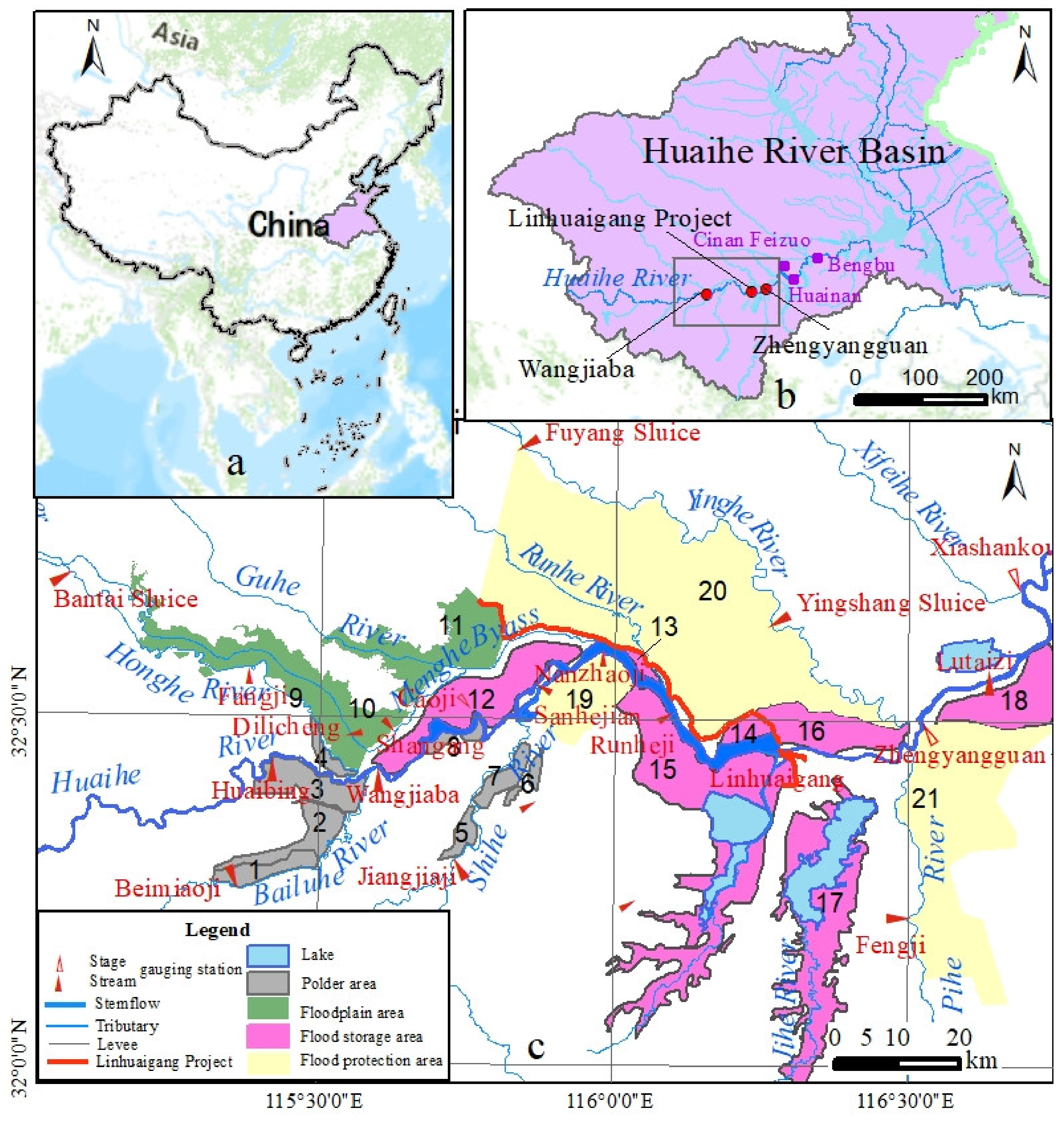
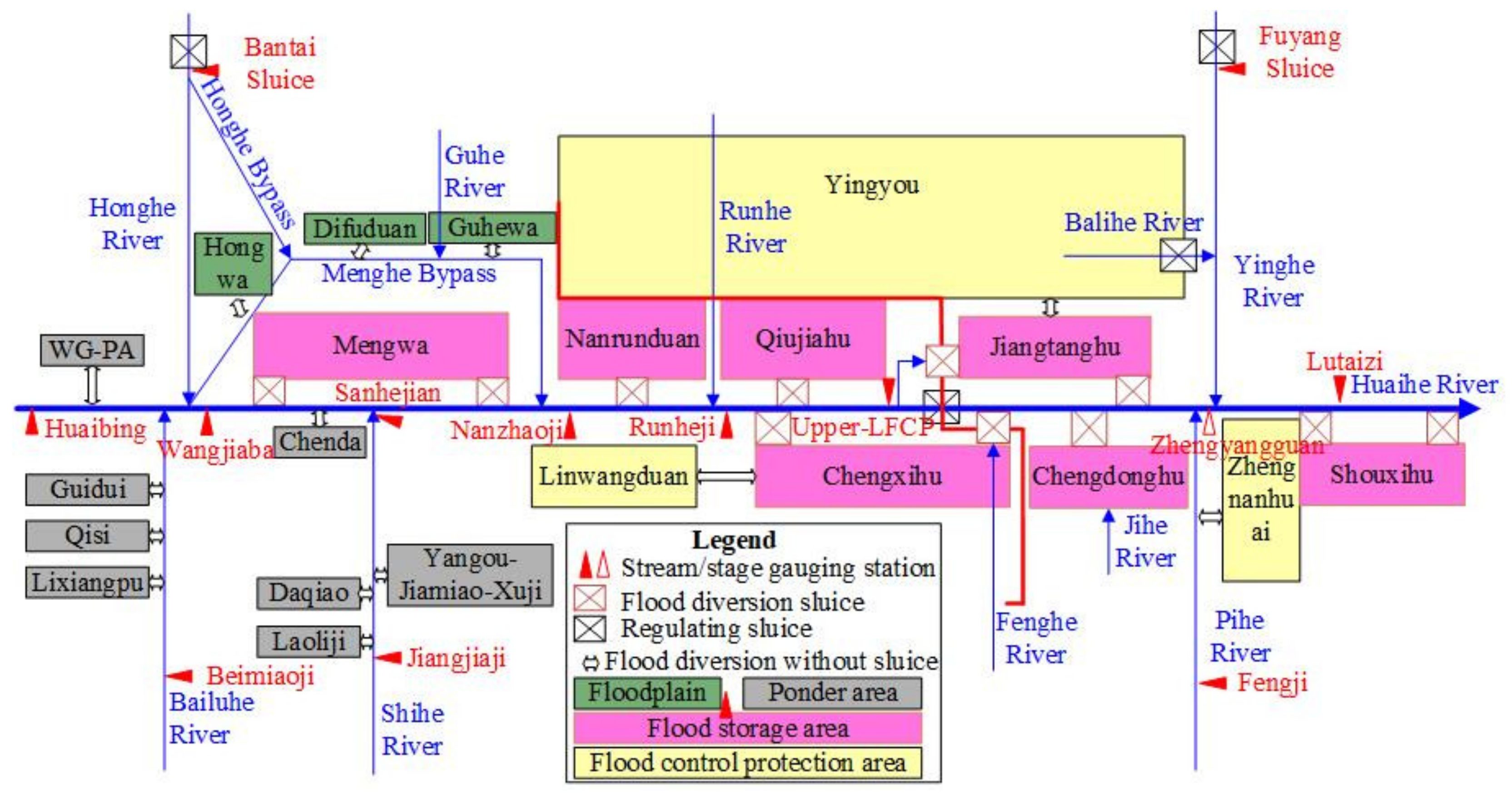

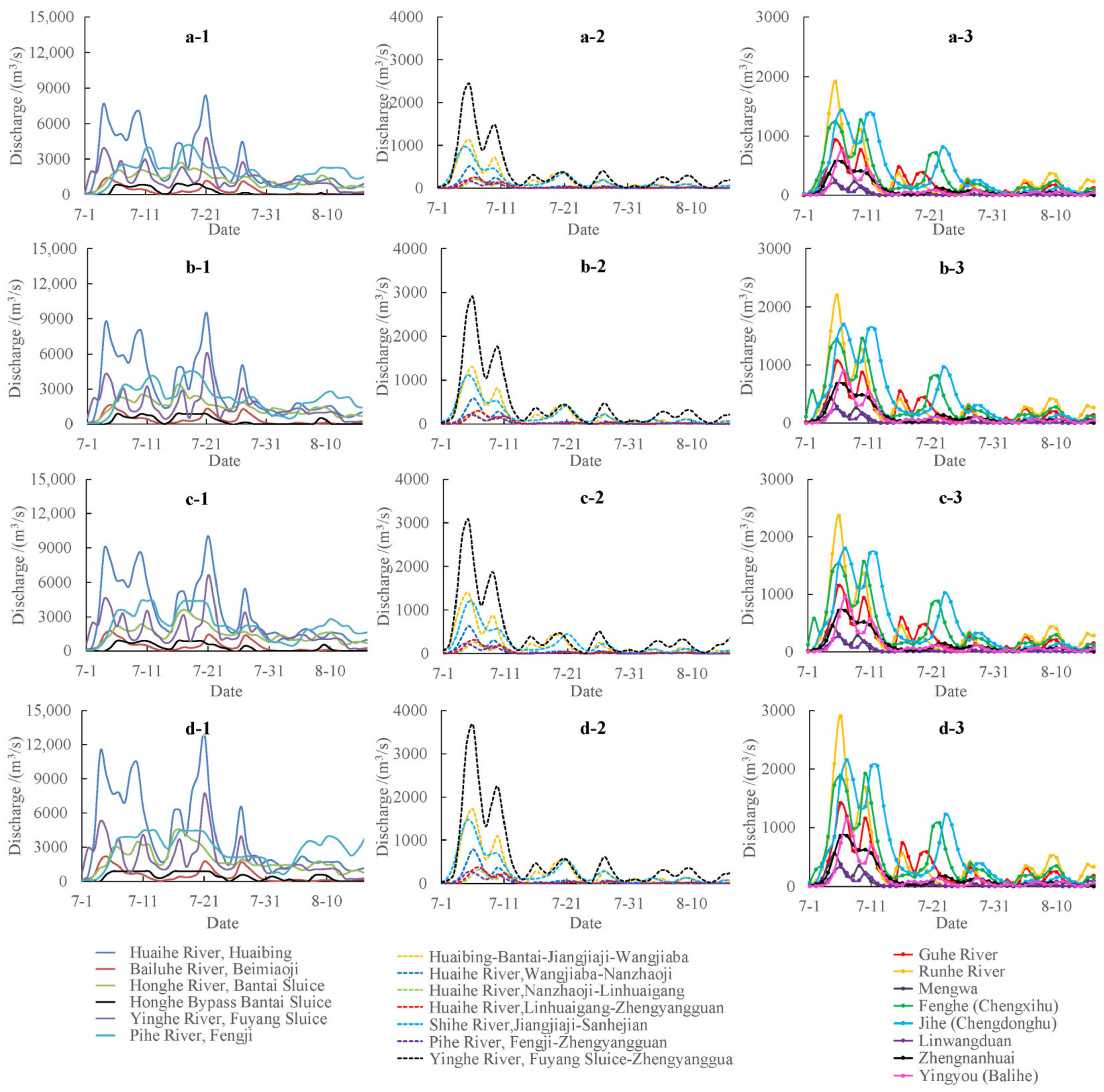
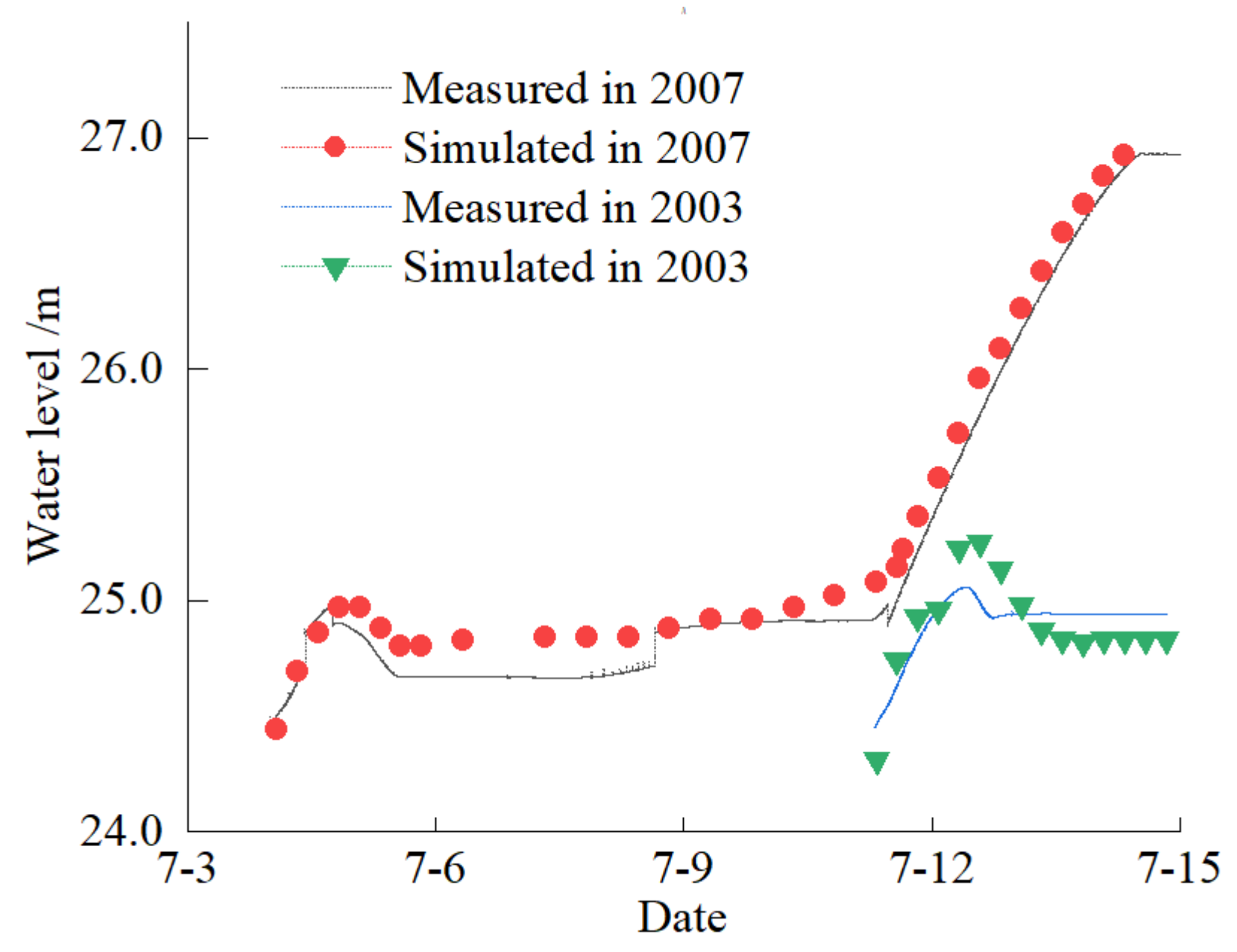
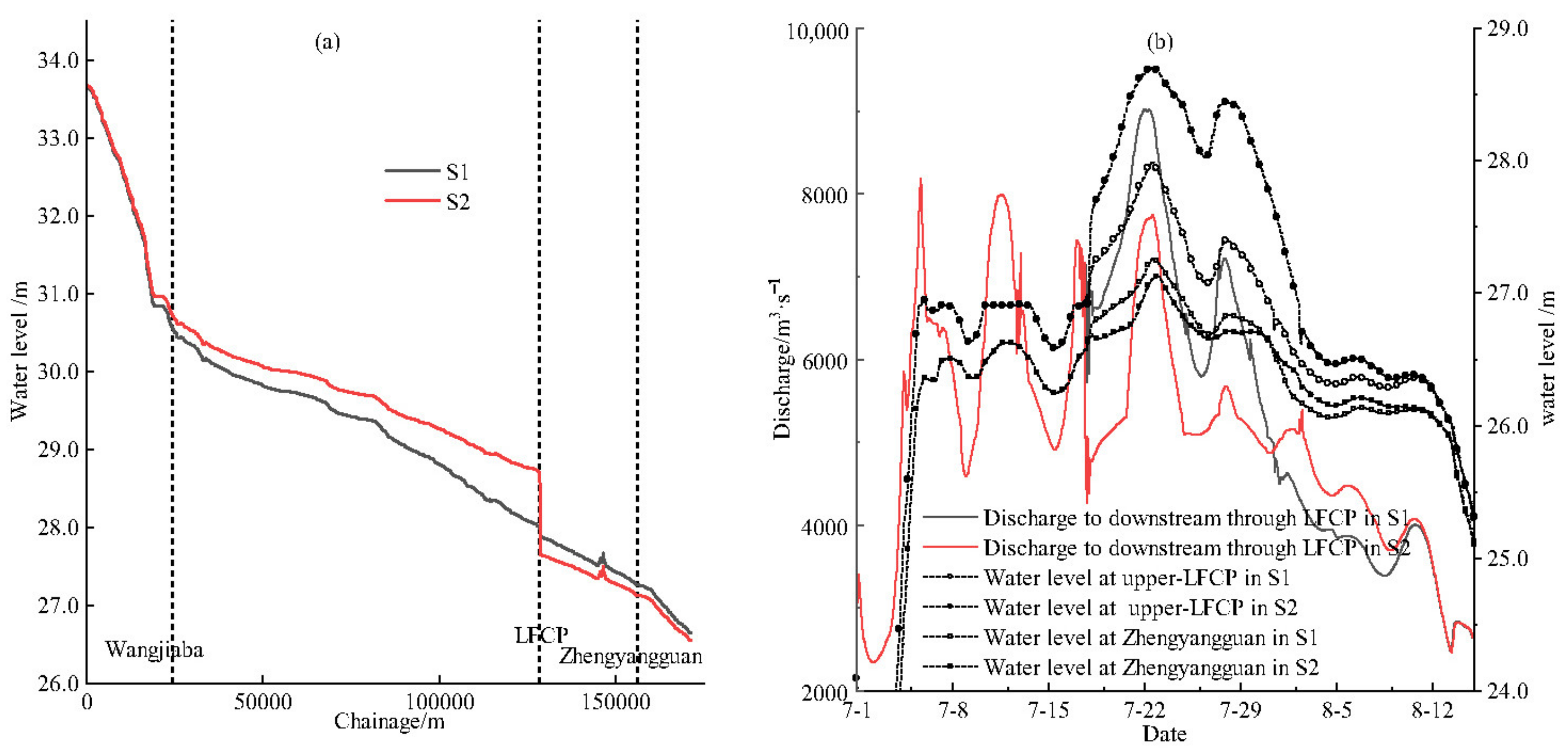
| Method | Area | Simulation Unit | In–Outflow | Link to the 1D Model |
|---|---|---|---|---|
| 0D | Polder area | Lixiangpu; Qisi; Guidui; Wanggang; Laoliji; Yangou–Jiamiao–Xuji; Chenda; Daqia | Breach | Side structure |
| 1D | River channels | Huaihe River from Huaibin to Lutaizi SGS (201 km); Honghe River from Bantai Sluice SGS to estuary (74.06 km); Honghe Bypass areas from Bantai Sluice SGS to estuary (70.72 km); Bailuhe River from Beimiaoji SGS to estuary (31.38 km); Menghe Bypass areas (48.5 km); Shihe River from Jiangjiaji SGS to estuary (40.14 km); Yinghe River from Fuyang Sluice SGS to estuary (206.64 km); Pihe River from Fengji SGS to estuary (54.40 km) | / | / |
| 2D | Flood-control-protected area | Lingwangduan; Yingyou; Zhengnanhuai | Breach | Standard link |
| Flood storage area | Mengwa; Qiujiahu; Nanrunduan; Chengxihu; Chengdonghu; Jiangtanghu; Shouxihu | Flood diversion sluice | Standard link | |
| Floodplain area | Hongwa; Difuduan; Guhewa | Overflow | Lateral link |
| Subregion | Maximum 30-Day Flood Volume (billion m3) | Peak Discharge (m3/s) | |||||||
|---|---|---|---|---|---|---|---|---|---|
| 100 Years | 200 Years | 300 Years | 1000 Years | 100 Years | 200 Years | 300 Years | 1000 Years | ||
| Huaihe River | Upstream of Huaibing | 9.44 | 10.82 | 11.96 | 17.43 | 8380 | 9530 | 10,048 | 13,005 |
| Huaibing to Wangjiaba * | 0.95 | 1.09 | 1.17 | 1.44 | 1916 | 2193 | 2364 | 2906 | |
| Wangjiaba to Nanzhaoji | 0.22 | 0.26 | 0.28 | 0.34 | 519 | 593 | 640 | 787 | |
| Nanzhaoji to Linhuaigang | 0.10 | 0.12 | 0.13 | 0.16 | 213 | 243 | 262 | 323 | |
| Linhuaigang to Zhengyangguan | 0.13 | 0.16 | 0.17 | 0.20 | 253 | 299 | 318 | 381 | |
| Bailuhe River | Upstream of Beimiaoji | 1.29 | 1.48 | 1.59 | 1.96 | 1439 | 1647 | 1775 | 2183 |
| Honghe River | Upstream of Bantai Sluice | 4.05 | 4.76 | 4.82 | 6.14 | 2713 | 3313 | 3601 | 4550 |
| Honghe Bypass | Upstream of Bantai Sluice | 0.99 | 1.07 | 1.18 | 1.50 | 880 | 880 | 880 | 880 |
| Shihe River | Upstream of Jiangjiaji | 4.69 | 5.30 | 5.79 | 6.72 | 4793 | 6088 | 6621 | 7664 |
| Jiangjiaji to Sanhejian | 0.68 | 0.78 | 0.84 | 1.03 | 964 | 1103 | 1190 | 1463 | |
| Yinghe River | Upstream of Fuyang Sluice | 5.78 | 6.68 | 7.17 | 7.76 | 4191 | 4244 | 4364 | 4430 |
| Fuyang Sluice to Zhengyangguan | 1.36 | 1.62 | 1.71 | 2.05 | 2445 | 2895 | 3068 | 3678 | |
| Pihe River | Upstream of Fengji | 4.12 | 5.18 | 5.75 | 6.56 | 3314 | 3670 | 4048 | 4583 |
| Fengji to Zhengyangguan | 0.11 | 0.13 | 0.14 | 0.16 | 176 | 208 | 221 | 265 | |
| Guhe River | 0.71 | 0.81 | 0.87 | 1.08 | 1132 | 1296 | 1398 | 1718 | |
| Runhe River | 0.69 | 0.79 | 0.85 | 1.04 | 935 | 1070 | 1153 | 1418 | |
| Mengwa | 0.18 | 0.21 | 0.23 | 0.28 | 368 | 421 | 453 | 557 | |
| Chengxihu (Fenghe River) | 1.09 | 1.30 | 1.40 | 1.67 | 1269 | 1452 | 1566 | 1925 | |
| Chengdonghu (Jihe River) | 1.37 | 1.64 | 1.74 | 2.08 | 1432 | 1695 | 1796 | 2153 | |
| Linwangduan | 0.10 | 0.12 | 0.13 | 0.16 | 221 | 253 | 273 | 335 | |
| Zhengnanhuai | 0.42 | 0.50 | 0.53 | 0.64 | 569 | 673 | 713 | 855 | |
| Yingyou (Balihe River) | 0.37 | 0.44 | 0.47 | 0.56 | 760 | 900 | 954 | 1144 | |
| Scheme Number | Hydrographic Condition | Operating Mode Condition |
|---|---|---|
| S1 | 100-year return period flood | LFCP not used |
| S2 | 100-year return period flood | LFCP used |
| S3 | 200-year return period flood | LFCP used |
| S4 | 300-year return period flood | LFCP used |
| S5 | 1000-year return period flood | LFCP used |
| River Breach | Stream Gauging Station | Peak Water Stage in 2007 | Peak Water Stage in 2003 | ||||
|---|---|---|---|---|---|---|---|
| Simulated /m | Measured /m | D-Value /cm | Simulated /m | Measured /m | D-Value /cm | ||
| Honghe river | Fangji | 31.94 | 32.06 | −11.70 | 31.50 | 31.63 | −13.50 |
| Honghe Bypass | Dilicheng | 29.41 | 29.60 | −19.50 | 29.17 | 29.28 | −11.00 |
| Menghe Bypass | Shangang | 29.28 | 29.29 | −1.39 | 28.95 | 28.94 | 0.68 |
| Shihe river | Jiangjiaji | 32.77 | 32.86 | −9.10 | 33.31 | 33.39 | −8.00 |
| Yinghe river | Fuyang Sluice | 29.68 | 29.82 | −14.10 | 29.16 | 29.31 | −14.90 |
| Huaihe river | Wangjiaba | 29.48 | 29.42 | 6.23 | 29.29 | 29.22 | 7.18 |
| Sanhejian | 28.55 | 28.49 | 5.78 | 28.21 | 28.34 | −13.23 | |
| Nanzhaoji | 28.15 | 28.17 | −1.58 | 27.85 | 27.88 | −3.58 | |
| Runheji | 27.66 | 27.66 | −0.19 | 27.45 | 27.46 | −0.80 | |
| Upper-LFCP | 27.02 | 27.00 | 2.40 | / | / | / | |
| Down-LFCP | 26.85 | 26.82 | 3.30 | / | / | / | |
| Zhengyangguan | 26.29 | 26.30 | −1.30 | 26.70 | 26.69 | 1.13 | |
| River Breach | Roughness Value/(s/m1/3) | |
|---|---|---|
| Overflow Land | Main River Channel | |
| Honghe River | 0.040–0.047 | 0.025–0.030 |
| Honghe Bypass | 0.035 | 0.025 |
| Bailuhe River | 0.037 | 0.026 |
| Menghe Bypass | 0.04 | 0.026 |
| Shihe River | 0.036 | 0.025 |
| Yinghe River | 0.040–0.047 | 0.024–0.028 |
| Pihe River | 0.04 | 0.035 |
| Huaihe River | 0.036–0.040 | 0.024–0.026 |
| Stream Gauging Station | Peak Water Stage/m | ||||
|---|---|---|---|---|---|
| S1 | S2 | S3 | S4 | S5 | |
| Huaibing | 33.65 | 33.67 | 34.23 | 34.59 | 35.85 |
| Wangjiaba | 30.54 | 30.71 | 31.33 | 31.60 | 32.37 |
| Sanhejian | 29.39 | 29.70 | 30.31 | 30.54 | 31.03 |
| Nanzhaoji | 29.15 | 29.51 | 30.08 | 30.30 | 30.73 |
| Runhejian | 28.67 | 29.17 | 29.62 | 29.81 | 30.17 |
| Upper LFCP | 27.98 | 28.70 | 28.96 | 29.07 | 29.37 |
| Zhengyangguan | 27.26 | 26.90 | 27.45 | 27.43 | 27.96 |
| Project Name | The Moment Put into Use | ||||
|---|---|---|---|---|---|
| S1 | S2 | S3 | S4 | S5 | |
| Mengwa | 4 July 1:00 | 4 July 1:00 | 3 July 21:00 | 3 July 20:00 | 3 July 15:00 |
| Nanrunduan | 4 July 22:00 | 4 July 22:00 | 4 July 13:00 | 4 July 12:00 | 4 July 4:00 |
| Chengxihu | 5 July 14:00 | 5 July 14:00 | 5 July 2:00 | 4 July 23:00 | 4 July 14:00 |
| Chengdonghu | 6 July 22:00 | 6 July 22:00 | 5 July 18:00 | 5 July 6:00 | 4 July 20:00 |
| Qiujiahu | 4 July 10:00 | 4 July 10:00 | 4 July 4:00 | 4 July 2:00 | 3 July 21:00 |
| Jiangtanghu | 5 July 13:00 | 5 July 13:00 | 5 July 1:00 | 4 July 22:00 | 4 July 15:00 |
| Shouxihu | 5 July 7:00 | 5 July 7:00 | 4 July 20:00 | 4 July 16:00 | 4 July 10:00 |
| LFCP | / | 17 July 18:00 | 11 July 9:00 | 9 July 22:00 | 7 July 8:00 |
| Flood Storage Area | Design Value | Flood Storage Volume/108 m³ | |||||
|---|---|---|---|---|---|---|---|
| Volume/108 m³ | Water Stage/m | S1 | S2 | S3 | S4 | S5 | |
| Mengwa | 7.5 | 27.7 | 8.33 | 8.97 | 9.74 | 10.02 | 10.48 |
| Nanrunduan | 0.64 | 26.4 | 0.77 | 0.82 | 0.86 | 0.96 | 1.59 |
| Chengxihu | 28.8 | 27.6 | 30.62 | 33.84 | 36.39 | 37.31 | 40.52 |
| Qiujiahu | 1.7 | 26.9 | 4.56 | 8.68 | 13.29 | 15.83 | 20.21 |
| Chengdonghu | 15.3 | 25.5 | 9.93 | 9.43 | 9.25 | 9.25 | 7.46 |
| Name of Flood-Control-Protected Area | Inundation Area/Million m2 | Average Water Depth/m | ||||||||
|---|---|---|---|---|---|---|---|---|---|---|
| S1 | S2 | S3 | S4 | S5 | S1 | S2 | S3 | S4 | S5 | |
| Yingyou | 0 | 0 | 819 | 879 | 1040 | 0 | 0 | 2.13 | 2.16 | 2.30 |
| Linwangduan | 131 | 132 | 134 | 134 | 135 | 4.50 | 4.80 | 5.23 | 5.43 | 5.78 |
| Zhengnanhuai | 0 | 0 | 425 | 436 | 459 | 0 | 0 | 1.75 | 1.86 | 1.93 |
| Chenda | 27 | 27 | 28 | 28 | 30 | 4.49 | 4.91 | 5.59 | 5.65 | 6.65 |
| Yangou–Jiamiao–Xuji | 0 | 0 | 57 | 57 | 59 | 0 | 0 | 4.00 | 4.99 | 6.15 |
| Daqiao | 0 | 0 | 35 | 35 | 35 | 0 | 0 | 4.29 | 5.86 | 7.34 |
| Laoliji | 0 | 0 | 39 | 40 | 41 | 0 | 0 | 2.60 | 3.84 | 5.22 |
| Gudui | 0 | 0 | 67 | 79 | 124 | 0 | 0 | 1.40 | 2.31 | 3.49 |
| Wanggang | 0 | 0 | 55 | 55 | 63 | 0 | 0 | 1.64 | 3.20 | 5.89 |
| Qisi | 0 | 0 | 27 | 28 | 29 | 0 | 0 | 3.15 | 4.11 | 4.93 |
| Lixiangpu | 0 | 0 | 26 | 48 | 74 | 0 | 0 | 1.25 | 1.67 | 3.24 |
| Floodplain Area | From the Floodplain Area to the River/108 m3 | From the River to the Floodplain Area/108 m3 | ||||||||
|---|---|---|---|---|---|---|---|---|---|---|
| S1 | S2 | S3 | S4 | S5 | S1 | S2 | S3 | S4 | S5 | |
| Guhewa | 2.27 | 2.04 | 4.23 | 8.59 | 8.49 | 0.17 | 0.42 | 0.69 | 0.41 | 5.07 |
| Difuduan | 0.14 | 0.17 | 0.41 | 0.49 | 0.71 | 0.55 | 0.64 | 1.56 | 2.58 | 5.30 |
| Hongwa | 0.00 | 0.00 | 0.01 | 0.01 | 0.10 | 0.01 | 0.01 | 0.37 | 0.87 | 2.79 |
Disclaimer/Publisher’s Note: The statements, opinions and data contained in all publications are solely those of the individual author(s) and contributor(s) and not of MDPI and/or the editor(s). MDPI and/or the editor(s) disclaim responsibility for any injury to people or property resulting from any ideas, methods, instructions or products referred to in the content. |
© 2024 by the authors. Licensee MDPI, Basel, Switzerland. This article is an open access article distributed under the terms and conditions of the Creative Commons Attribution (CC BY) license (https://creativecommons.org/licenses/by/4.0/).
Share and Cite
Hu, Y.; Qin, T.; Dong, G.; Chen, X.; Ruan, H.; Zhang, Q.; Wang, L.; Wang, M. Flood Modeling in a Composite System Consisting of River Channels, Flood Storage Areas, Floodplain Areas, Polder Areas, and Flood-Control-Protected Areas. Water 2024, 16, 825. https://doi.org/10.3390/w16060825
Hu Y, Qin T, Dong G, Chen X, Ruan H, Zhang Q, Wang L, Wang M. Flood Modeling in a Composite System Consisting of River Channels, Flood Storage Areas, Floodplain Areas, Polder Areas, and Flood-Control-Protected Areas. Water. 2024; 16(6):825. https://doi.org/10.3390/w16060825
Chicago/Turabian StyleHu, Yong, Tianling Qin, Guoqiang Dong, Xiaofeng Chen, Hongwei Ruan, Qibing Zhang, Lei Wang, and Minjie Wang. 2024. "Flood Modeling in a Composite System Consisting of River Channels, Flood Storage Areas, Floodplain Areas, Polder Areas, and Flood-Control-Protected Areas" Water 16, no. 6: 825. https://doi.org/10.3390/w16060825
APA StyleHu, Y., Qin, T., Dong, G., Chen, X., Ruan, H., Zhang, Q., Wang, L., & Wang, M. (2024). Flood Modeling in a Composite System Consisting of River Channels, Flood Storage Areas, Floodplain Areas, Polder Areas, and Flood-Control-Protected Areas. Water, 16(6), 825. https://doi.org/10.3390/w16060825







